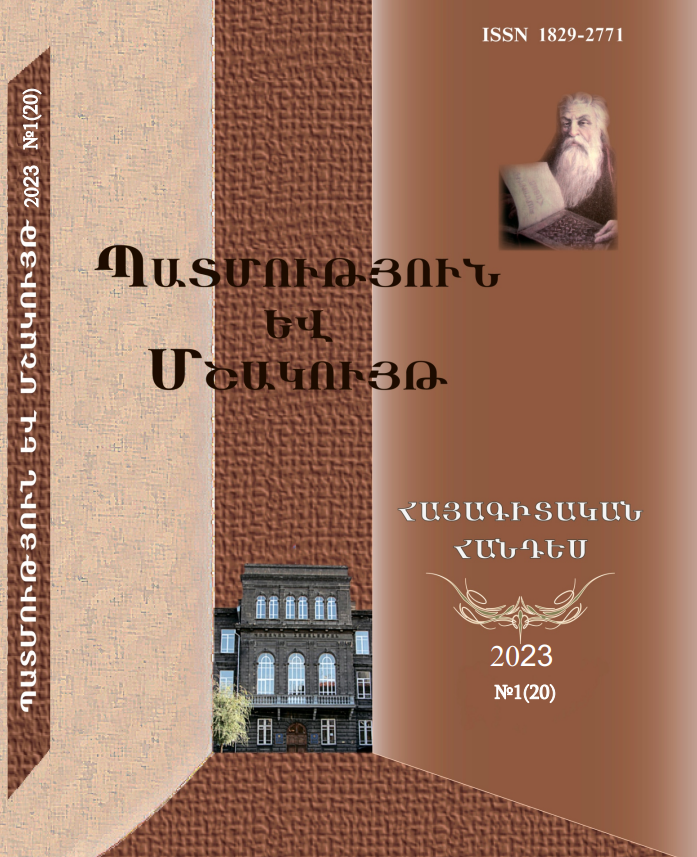An Episode from the History of the Armenian Kingdom of Cilica and Church Relations (1198-1219)
DOI:
https://doi.org/10.46991/hc.2023.20․2․031Keywords:
Cilicia, political, Rome, Papacy, power, king, archbishop, Armenian Church, state, theology , religion, proclamation.Abstract
The article addresses a certain and very important aspect of the relations between Cilican Armenia and Holy Roman Empire – the proclamation of the Armeinan Kingdom of Cilicia and the coronation of Prince Levon II. Based on the information available in medieval Armenian and foreign historical sources, as well as the modern scientific literature of the question, the author has managed to present the international situation from the late 80s of the 12th century to 1198, the Armenian-Roman and Armenian-Byzantine relations and the process of the coronation of King Levon II. The article contains detailed information about the negotiation process between Cilician Armenia and the two powers of the time – the Holy Roman Empre and the Byzantine Empire as well as the final decisions achieved. Special attention has been attached to the religious changes offered by the Catholic Church to the Armenian Prince of Cilicia. The article also addresses the issue of the anointment of Prince Levon II and substantiates the fact that it was performed by Archbishop Conrad Wittlesbach, the representative of the Pope of Rome and the Holy Empire. Armenian Catholicos Grigor VI Apirat blessed him.
References
Alishan, Ghevond (1885). Sisouan, Homography of Armenian Cilica and Levon the Great (in Armenian). Venice, St. Lazarus.
Boase, T. S. R. (1978). The Cilician Kingdom of Armenia. Scottish Academic Press, London.
Brocarduc, (1906). Directorium ad Passagium Faciendum. Recueil des Historiens des Croisades, doc. Arme’niens, t. II, Paris.
Cahen, C. (1840). La Syrie du Nord a` I`epoque des Croisades et la principaute franque d` Antiock, Paris, Available at https://books.openedition.org/ifpo/6189
Chronoliques d' Amadi et de strambaldi, (1891). Paris, Imprimerie nationale.
Colophon of Armenian Manuscripts of 12th century (1988). (in Armenian). Yerevan, AAS Publishers.
Der-Nersisian, Sirarpi (1969). The Kingdom of Cilician Armenia. In Kenneth M. Setton, A
History of the Crusades, Madison-Milwaukee-London, 1966, pp. 630-659.
de Tyr, Guillaume (1859). L’Estoire de Eracles empereur et la conquest de la terre d’Outremer, Recueil des historiens des Croisades, Hostoriens cccidentaux. Paris, Imprimerie imperial.
Chronique D’Ernoul et de Bernard Le Tre’sorier (1871). Paris, Vve de J. Renouard.
Grousset, R. (1949). L’ Empire du Levant, Histoire De la Question D` Orient. Paris.
Halfter, P. (1996). Das Papstum und die Armenier im fruhen und hohen Mittelalter։ Von den ersten kontakten biz zur fixierung der kirchenunionim. Jaher 1198, Wien.
Halfter, Peter (2009). L’E՛glise arme’nienne entre la papaute’ et les Byzantins aux XII et XIII sie՝cles. In L’E’glise arme’nienne entre Grecs et latins, Fin XIe - milieu XVe siècle, Paris, Geuthner, pp.63-78.
Ibn Al-Athir (1981). Complete History (in Armenian). Foreign Sources about Armenia and Armenians, vol. 1, Yerevan, Academy of Sciences of Arm. SSR Press.
Gandzaketsi, Kirakos (1961). Armenian History (in Armenian) ed. by Melik-Ohanjanyan A., Yerevan.
Langlois, Victor (1863). Le tre’sor des chartes d’ Armen’ie. Venise, Typographie de Saint- Lazare.
Levon I (2019). Ein armenischer Konig im staufischen Outremer. Halle (Zalle).
Asori, Michael (1870). Armenian Chronology (in Armenian), Jerusalem.
Chevalier, Marie-Anna (2007). Sur L’Histoire Des Relations De E` Armenie Cilicienne avec les orders Religieux-Militaires (in Armenian). Editions De L’ Universite, D` Etat D` Erevan, Erevan, YSU Press.
Mikayelyan, Grigor (2007). History of the Armenian State of Cilicia. (in Armenian). Yerevan, YSU Press.
Moeller, Stefan (2019). The Armenian King Levon I, Ein armenischer Konig im staufischen Outremer. Halle/Saale, Kulturstiftung Sachsen-Anhalt.
Morgan, J. (1919). Histoire du people Armen’nien. Paris. Berger-Levrault librarires- Editeurs.
Mutafian, Claude (2001). Cilicia at the Crossroads of Empires (in Armenian). Yerevan, Nairi Publishers.
Mutafian, Claude (2002a). La diplomatic arme’nienne au Levant a` Iepoque des croisades XII-XVI sie`cle. Paris, Paris 1.
Mutafian, Claude (2002b). Reserches sur I` Armen’nie cilicienne. Paris, Pais 1.
Ormanyan, Maghakia (2001). National History, (in Armenian) Vol. I, Echmiadzin.
Runciman, Steven (2005). A history of the Crusades (in Armenian). In L. Ter-Petrosyan, The Crusadors and Armenians, vol. 1, Yerevan, Print Info.
Rudt-Collenberg, W. H. (1963). The Rupenides, Hethumides and Lusignans, The Structure of the Armeno-Cilician dynasties, Paris, Klincksieck, First edition.
Samvel Anetsi et al (2014). From Adam to 1776 (in Armenian) with the support of K. Matevosyan. Yerevan, Nairi Publishers.
Smbat Sparapet, (1956). Yearbook (in Armenian). Venice. St Lazaro.
Short Chronologies of the XIII-XVIII centuries (1956). Vol․ II, Yerevan, NAS RA.
Syuremyan, Artavazd (1945). The Armenian-Latin relations in the light of Greek-Latin relations (in Armenian). Echmiadzin Journal , N 1-2, pp. 16-23.
Ter-Petrosyan Levon (2005). Crusaders and Armenians, Vol. I, The Empire of Levante (in Armenian). Yerevan, Print Info.
Ter-Petrosyan Levon (2007). Crusaders and Armenians (in Armenian) vol. II, Yerevan, Print Info.
Rabouni, Vahram (1856). The History of the Rubenids (in Armenian). Paris, Shahnazariants Publishers.
Areveltsi, Vardan (1862). Historical Compilation (in Armenian). Venice, St Lazarus.
Downloads
Published
Issue
Section
License
Copyright (c) 2023 Nelli Zhamkochyan

This work is licensed under a Creative Commons Attribution-NonCommercial-ShareAlike 4.0 International License.

